 |
| Arrival of
the train from Fulda at the Vallendar station Ankunft des Sonderzuges am Bahnhof Vallendar |
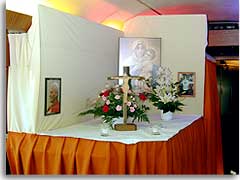 |
| "Train Shrine":
Jesus and Mary on pilgrimage with the pilgrims "Zug-Heiligtum": Jesus und Maria unterwegs mit den Pilgern |
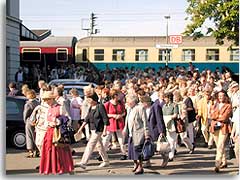 |
| The pilgrims
from the Fulda diocese gathering for the procession to Schoenstatt
Sammlung zur Prozession nach Schönstatt |
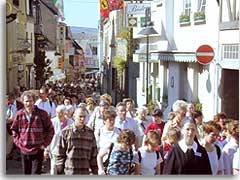 |
| Procession
through the city of Vallendar Prozession durch die Fußgängerzone in der Stadt Vallendar |
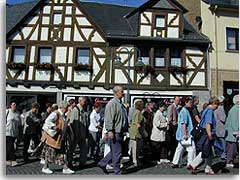 |
| The historical
buildings in Vallendar and the decoration of the inner city make a
perfect background for the procession Die historischen Gebäude in Vallendar und die schön gestaltete Fußgängerzone bilden einen malerischen Hintergrund für die Prozession |
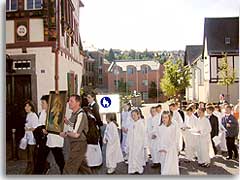 |
| In the background:
Vallendar city hall Im Hintergund: Rathaus |
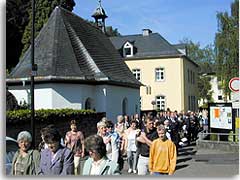 |
| Arrival by
the Original Shrine Ankunft am Urheiligtum |
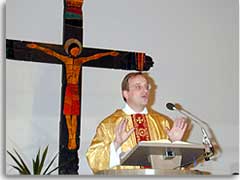 |
| Father Liebig,
Fulda diocesan leader, gave the sermon Pfarrer Liebig, Diözesanpräses, hielt die Predigt |
 |
| Approximately
70 First Holy Communion children participated together with thier
families Das gehört zur Fuldaer Wallfahrt: etwa 70 Kommunionkinder und ihre Familien waren dabei |
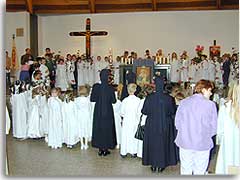 |
| Afternoon
Marian prayer service: Procession of First Holy Communion children
Marienfeier am Nachmittag: Prozession der Kommunionkinder |
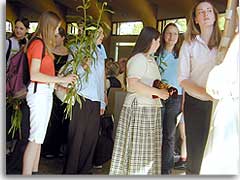 |
| The Schoenstatt
Girls' Youth gave witness of the "living crown" and carried the crown
from the Shrine through the Church and to the Original Shrine Die Schönstatt-Mädchenjugend gab Zeugnis von der Erfahrung der "lebenigen Krone" und trug die Krone vom Heiligtum durch die Kirche und zum Urheiligtum |
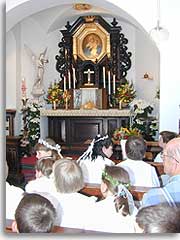 |
| Farewell visit
in the Original Shrine at the end of the pilgrimage Am Schluss der Wallfahrt ein Besuch im Urheiligtum |
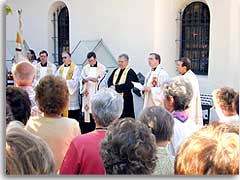 |
| Father Matthias
Rummel SAC welcomed the pilgrims Begrüßung durch Pater Matthias Rummel SAC |
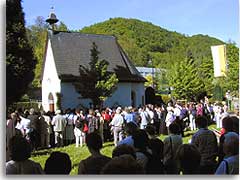 |
| Gathering
around the Original Shrine, the home of countless persons in the world Versammelt ums Urheiligtum, wo unzählige Menschen aus aller Welt zu Hause sind |
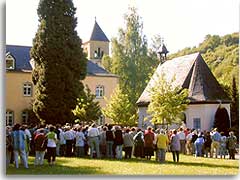 |
| "We bring
to you all our loved ones, all those about whom we worry and who are
a burden for us ..." "Wir bringen dir die Menschen, die wir lieb haben, alle, um die wir uns Sorgen machen und die uns belasten." |
| Fotos: PressOffice Schönstatt, Brehm © 2001 |
(mkf) Sharing the experiences of faith in order to create a new atmosphere of hope in the church – this challenge was given to the 1,000 or so pilgrims from the Fulda diocese on may 13, 2001. Diocesan Leader Fr. Liebig asked the pilgrims in Schoenstatt to join forces to transform the general attitude of resignation into an attitude of joyful hope, following the encouragement given by Father Kentenich, by demonstrating that holy places like Schoenstatt work for the education of holy and sound persons. The most important task however in order to give the profile of hope to the church – "that others know and experience: You are welcome here, you are welcome with all of your shortcomings. And because you come we celebrate with you!" The pilgrims, among them 70 or so children who had recently had their first Holy Communion – dressed in their festive blue and white – had come with a special train and processed through the city of Vallendar heading for Schoenstatt, singing and praying.
For the 26th time, Diocesan Leader Liebig emphasized, Fulda pilgrims had set out from the tomb of St. Bonifatius and come to Schoenstatt – this time on a day with picture perfect weather not too common in this area! Like each year, the pilgrims formed a procession after arriving at Vallendar station with an extra train. The tunes of a brass band, singing and praying resounded early on Sunday morning in the inner city of Vallendar, with the children in their festive dresses, the many youth and young families making for a contagiously hopeful picture of a joyful church. A lady carrying a Pilgrim MTA, decorated with a yellow-and-white ribbon, looks at her with a deep smile. The deep blue of the skies, the intensive spring colors and the radiant sun added a special savor to the scene.
With Mary, Joyfully in Hope Into the Third Millennium
"Are we people of hope?" A question brought to the pilgrims at the beginning of the sermon. According to latest opinion polls, Father Liebig explained, the general attitude of the church in Germany is that of frustration and resignation. "We do not want to be contaminated by this general attitude," he said, "because we know and experience hope and joy in our church!" What contributes to a church, to a community, a movement marked by hope?
A first prerequisite, he stated, is sharing one's own experiences of faith. The personal experience would create interest in the Gospel, not lectures! "People begin to listen when we share our own experiences and pass them on to as many others as possible," he said. In his own Schoenstatt community – the Federation of Diocesan Priests -, and in many others it has become a custom to share one's own experiences of faith with others. Why not share tomorrow with neighbors and on the work place that one participated when 1,000 or so persons had set out to be in a small Chapel, the cradle of an international movement?
Schoenstatt, he added, is not one of the "usual" Marian places of pilgrimage. It is a place where Mary, the Mother of God, wants to work as educator. She wants to form holy and healthy strong personalities from her Shrine. Holy persons "growing" at holy places – a promise and important second prerequisite for a church marked by hope.
To Be Sure To Be Welcome
A third characteristic feature of a church marked by joyful hope, Fr. Liebig said, would be the moment of feast and celebration. How celebrate and why? The answer was a surprise and challenge for the pilgrims and not only for them: "Who ever comes in touch with the church should be sure to be welcome!" It would be important to learn a loving way of approaching those who have problems with standards of the church, a way marked by respect and openness of the heart. Church, he said, is more than the issue of sacraments, and what matters would be that persons like homosexuals, re-married divorced couples, persons who have failed in one or more "standards" or life, as well as the big number of "semi-believers" who would look for a contact with the church without being willing or able to fully commit themselves would, like the "Christmas-only worshippers" would feel welcome: "Instead of thinking or saying: What do they want here? They take my seat! – We should care that they feel welcome! We are not only called of the perfect ones! We want others to know and experience: here you are welcome with all of your shortcomings, and when you come we celebrate!"
Strength to Go On When Things Are Hard: Mary the Queen
Each year, the Fulda Schoenstatt Movement brought one symbol from their diocesan Shrine in Dietershausen to Schoenstatt for the pilgrimage: the Father eye symbol, the Holy Spirit ... This year, the Schoenstatt Girls' Youth became active – they wanted the crown of the Blessed Mother. Since the International Meeting in August 2000, with the experience of the "living crown" for Mary, the girls want to pass in this to the entire Schoenstatt Movement. They did not take the crown from the Shrine on the day before the pilgrimage but weeks before, so this crown could visit the girls before. During the afternoon Marian prayer service, the girls shared texts from their International Meeting and gave practical testimonies about their own experience with Mary in the Covenant of Love and the longing to be her living crown: in difficult exams, with 'boring' students, in moments of anxiety and lack of self-confidence, the girls had experienced:
- Living in Covenant love with Mary, being her living crown, gives strength, specially the strength to go on.
- Living in Covenant love with Mary, being her living crown, helps to see the others' strengths and qualities instead of their weaknesses and shortcomings.
- Living in Covenant love with Mary, being her living crown, gives strength when things become hard.
Before, Fr. Schäfer had outlined the meaning of Mary as a Queen: She is the Best, she has Influence, and she is genuine.
Before all went to the Original Shrine in procession, the communion children – with roses in their hands – and the girls from processed through the entire church, carrying the crown. With the blessing from the MTA in the Original Shrine, where the pilgrims entrusted themselves and their loved ones to Mary, they returned back to the places where they want to bear witness of a church marked by hope.